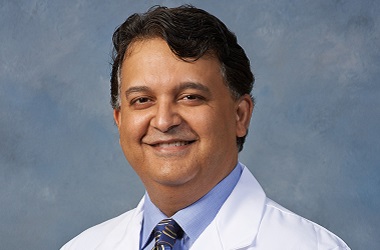
Ashish Shanbhag, MD joined National Spine & Pain Centers’ (NSPC) network of practices in 2012 after several years of private practice in South Carolina. Experienced and expertly trained, Dr. Shanbhag earned his medical degree from the Medical University of South Carolina – College of Medicine. He completed his residency in Physical Medicine & Rehabilitation at the University of Minnesota, followed by advanced fellowship training in Interventional Pain Management and then subsequently another fellowship in Electrodiagnostic Medicine (EMG/NCS). Dr. Shanbhag then went on to complete clinical postgraduate training in Endoscopic & Percutaneous Spine Surgery at Synergy Spine Center. He is one of only a few physiatrists both nationally and internationally to have completed advanced training in minimally-invasive spine surgery.
Q: Are there any specific treatments, technologies, or diagnostic specialties that you are particularly excited about?
A: My primary focus is on four areas:
- Spine Cancer: The office-based, outpatient treatment of cancer to the spine and sacrum with Radiofrequency Ablation to ablate (or “kill”) the tumor.
- Spine & Sacral Fractures: Spine Fracture Repair - Cementoplasty (Kyphoplasty/Vertebroplasty/Sacroplasty) is another office-based, outpatient setting, without the need for general anesthesia or hospital/surgery center care.
- Discogenic Low Back Pain: Herniated/Degenerated Disc treatment options in an office-based, outpatient setting with Regenerative Medicine.
- Spinal Stenosis: The use of Regenerative Medicine such as Dextrose/PRP/Platelet Lysate.
Q: What drew you to the field of pain management and/or anesthesiology?
A: In high school, I was an avid athlete who played football and tennis. My interest was in Sports Medicine at that time. After Medical School, I completed a Residency in Physical Medicine & Rehabilitation (PM&R); a specialty focusing on the non-surgical care of spine, sports, and orthopedic medicine. Interventional Pain Management was a natural extension of PM&R as it offers minimally-invasive and advanced procedures to diagnose and treat pain related to neuromusculoskeletal disorders. This in turn allowed patients to return to normal activities without the need for surgery or prolonged medication dependence.
Q: What is your approach to medication management as part of developing treatment plans?
A: Medication management can be a useful bridge to help reduce pain and permit functional activity while the patient undergoes diagnostic and subsequently therapeutic interventions. With advanced, minimally-invasive techniques, this then results in reduction of pain, thus allowing the physician and patient to gradually reduce and hopefully eliminate the medication reliance.
Q: What is your philosophy about doctor-patient interaction and patient-centered care?
A: This is the foundation of excellent patient care, outcomes and relationships. Partnering with the patient and their family – while setting realistic expectations – allows the patient to better understand and make the decisions they feel suit their individual needs.
Q: What do you like to do in your free time (hobbies, interests, etc.)
A: I enjoy playing golf, photography, and of course spending time with my family.
Q: What do you enjoy the most about your job? What drives you to do it?
A: The ability to identify a patient's orthopedic, spine and cancer pain issues, and return them to functionality while restoring their quality of life.
Q: Is there a particular treatment or technology on the horizon that has you excited about the future of pain management and the opportunities to help your patients?
A: Endoscopic Spine Surgery.
Q: What gets you excited about working at NSPC?
A: It is a truly a collaborative effort having colleagues in your own specialty. An added benefit is when patients move, we often have an affiliated office nearby where they can transfer their care. The fact we have the same electronic medical record platform makes it even easier, as patients do not have to worry about the burden of getting their records and having them sent to another physician.
Q: What would you do for a living if you weren’t a doctor?
A: I’d be a pilot!
Dr. Shanbhag treats chronic and acute pain related to:
Discogenic Low Back Pain (Herniated/Degenerated)
Ehlers-Danlos Syndrome
Facet Syndrome
Peripheral Neuropathy
Sacroiliac Joint Pain
Spinal Arthritis
Spinal Stenosis
Spine & Sacral Cancer
Spine & Sacral Fractures
Some of the treatments and procedures they perform include:
Bone Marrow Aspirate
Epidural Injections
Facet Injections
Platelet Lysate
Platelet Rich Plasma
Prolotherapy
Radiofrequency Neurotomy
Regenerative Medicine
Sacroiliac Joint Injections
Spinal Cord Stimulators
Spine Cancer Tumor Ablation
Spine Fracture Repair - Cementoplasty (Kyphoplasty/Vertebroplasty/Sacroplasty)




